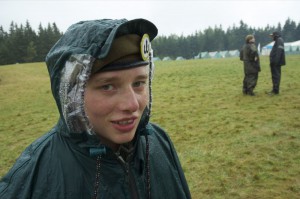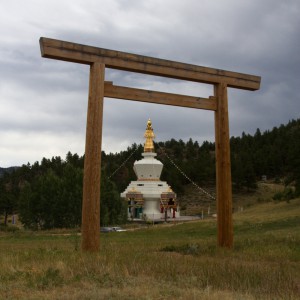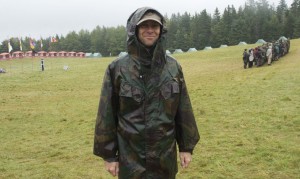Wednesday
Dharma TeachingsThe Gate of Cosmic Warfare
 Invoking the Energy of Protection
Invoking the Energy of Protection
by Toby Sifton, Rupon
There is a sentry at the gate 24 hours a day regardless of the activity happening within. Someone stands at the edge peering out from under a tarp against rain that never seems to end, or roasts in the sun waiting to see if someone will bring them lunch, or enjoys the firelight and gazes up at stars over the rest of the camp long asleep with the dew gathering on their boots. It is a funny gate from the standard idea, as there is no fence extending around the camp. One could easily enter from any direction. But all Dorje Kasung at the annual practice intensive of Magyal Pomra Encampment come through this gate, saluting to the space within, taking a moment to wake up, feel the earth below, and sky above, before plunging into the chaos.
From the gap after breathing out, to walking meditation, the day after dathun, moving to a new city, or getting divorced, the rubber meets the road at these transitions, these energetic gates from one moment of reality to the next. In the Shambhala tradition, we could chant a protector chant at dusk, the half-hour for the rods in our retina to kick in and allow us to see beyond the edge of the firelight, or the edge of light beyond our office door. Maybe we are tired and irritable from a long day but still have a stretch of work or driving before supper and a council meeting. Despite our fatigue and the fading light, we sharply rouse our mindfulness, reminding ourselves that, in the open space of a transition without the usual reference points, it is easy to slip, literally, or lose ourselves to discursiveness, or a fingertip to a vegetable knife. This is what it means to invoke the energy of protection. I often call it circling the wagons.
 On a monthly and seasonal level, this can be accomplished through celebration. We chant the Sadhana of Mahamudra on the new and full moon days and celebrate Summer’s warmth, Autumn’s harvest, and in the Winter, with Children’s Day, the joy of family, through practices and gatherings that rouse our understanding of the continuity of basic goodness, allowing us to enjoy the present moment of nowness, and not get too lost in daydreams. Then comes the ‘don’ period, the obstacle season, when things – unexpected, abrupt and maybe nasty – seem to more frequently cut this continuity of vision. It is the annual dusk, celebrated for the nine days leading up to Shambhala Day, the lunar New Year. I often look at it like this, using the classic yīnyáng diagram:
On a monthly and seasonal level, this can be accomplished through celebration. We chant the Sadhana of Mahamudra on the new and full moon days and celebrate Summer’s warmth, Autumn’s harvest, and in the Winter, with Children’s Day, the joy of family, through practices and gatherings that rouse our understanding of the continuity of basic goodness, allowing us to enjoy the present moment of nowness, and not get too lost in daydreams. Then comes the ‘don’ period, the obstacle season, when things – unexpected, abrupt and maybe nasty – seem to more frequently cut this continuity of vision. It is the annual dusk, celebrated for the nine days leading up to Shambhala Day, the lunar New Year. I often look at it like this, using the classic yīnyáng diagram:
Yīn is the shaded side of the mountain: cold, wet, contracting, heavy and dark. After the Winter Solstice, the earth just gets colder and colder. Everything contracts and contracts further and then ‘pop!’, the white dot of yáng is there, the natural transition from stillness to movement. Spring is still a way off and the ground is still frozen, but deep within the earth, the dragon of Summer is dreaming of Spring and the twitch of a tail sends cracks running through the ice. From the traditional Tibetan Buddhist perspective, all of our accumulated negative funk is ripening, and it is an especially important time to wake up, make an effort to clear out the old, and maybe bring that sentry on the edge a cup of tea and some cookies.
 At just such a time in February, 1980, Chogyam Trungpa addressed the Rusung, or Center Protectors, of Shambhala, who had gathered to celebrate this transition at his home in Boulder, the Kalapa Court, and he illustrated what remains for me as one of the simplest descriptions of how to take care of people, or not, and how obstacles might arise for them. This address is reprinted in True Command, a collection of talks given to Rusung and Kasung, most often during the Don seasons. He said, “Some people who had problems didn’t have anyone to talk to.” Trungpa Rinpoche then described a succinct, almost linear process, where this first lack of acknowledgement by others leads to resenting meditation practice and the community, weakening us further so we have more problems, which then invites attacks by further obstacles, which confirms the original problem; all because someone did not have anyone to talk to about their experience in the first place.
At just such a time in February, 1980, Chogyam Trungpa addressed the Rusung, or Center Protectors, of Shambhala, who had gathered to celebrate this transition at his home in Boulder, the Kalapa Court, and he illustrated what remains for me as one of the simplest descriptions of how to take care of people, or not, and how obstacles might arise for them. This address is reprinted in True Command, a collection of talks given to Rusung and Kasung, most often during the Don seasons. He said, “Some people who had problems didn’t have anyone to talk to.” Trungpa Rinpoche then described a succinct, almost linear process, where this first lack of acknowledgement by others leads to resenting meditation practice and the community, weakening us further so we have more problems, which then invites attacks by further obstacles, which confirms the original problem; all because someone did not have anyone to talk to about their experience in the first place.
In a traditional way, this is exactly what we are aiming to correct when we recite the Pacifying the Turmoil of the Mamos chant, over and over again, at Shambhala Centers each evening of this season. We advocate for the importance of listening, openly acknowledge discord and setting the intention to prevent it through better communication, through maintaining a strong connection to the view of basic goodness. “OM Samaya, AH Samaya, HUM Samaya,” is saying this, believe it or not. What is most fascinating about the Mamos chant, however, particularly in light of the Shambhala path of enlightened society, of social transformation, is that the Mamos chant seems to be specifically directed towards awareness of societal turmoil. From not listening, the quarrel grows to civil war, plagues, an age of weaponry, cosmic warfare and lots of blood.
 The magic part is that this is a potential gate into a different reality. Coming home from work, or approaching someone whose problems you would rather avoid, or acknowledging your own part in the development of the age of weaponry: these are all transitions where you have an opportunity to stop, feel the earth at your feet, the open sky, and your heart beating in the middle along with everyone else. The results of miscommunication have been exhaustively enumerated, and there is certainly plenty of chaos ahead, but the steadiness of earth and openness of sky are available. It helps to post sentries.
The magic part is that this is a potential gate into a different reality. Coming home from work, or approaching someone whose problems you would rather avoid, or acknowledging your own part in the development of the age of weaponry: these are all transitions where you have an opportunity to stop, feel the earth at your feet, the open sky, and your heart beating in the middle along with everyone else. The results of miscommunication have been exhaustively enumerated, and there is certainly plenty of chaos ahead, but the steadiness of earth and openness of sky are available. It helps to post sentries.
~~
Toby Sifton practices acupuncture in Brunswick, Maine, and is the Gesar Arm Commander of the Dorje Kasung sitting on the Council of the Makkyi Rabjam.





Feb 14, 2013
Reply
This is an eloquent article and a beautiful teaching. I’d like to print it out so I can re-read it.